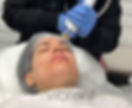RF Needling vs Microneedling Explained
- richardonna
- Dec 11, 2024
- 6 min read
Updated: Dec 12, 2024

Wondering about the difference between RF microneedling and microneedling? While both treatments boost collagen production, RF microneedling adds radiofrequency energy to penetrate deeper skin layers. Traditional microneedling creates tiny punctures to improve surface texture, while RF microneedling combines these micro-injuries with heat energy for enhanced skin tightening and scar reduction. Your choice depends on your specific skin concerns – surface-level improvement or deeper tissue remodeling.
Microneedling vs RF Needling – Key differences
Traditional Microneedling
Traditional microneedling treatment uses tiny needles to create micro-injuries in the skin, stimulating collagen production and improving skin texture. These minor skin injuries stimulate the skin's natural healing process, encouraging the production of skin-firming proteins like collagen and elastin. It's like hitting the refresh button on your skin!
Key benefits
Traditional micro-needling creates micro-injuries in the skin, triggering the body's natural healing process. This process stimulates collagen production, leading to improved skin texture. Say goodbye to rough, uneven skin and hello to a smoother, more refined complexion!
One of the hidden perks of traditional method is that it creates tiny channels in the skin, allowing your favorite skincare products to penetrate deeper and work more effectively. It's like giving your serums and moisturizers a VIP pass to your skin's inner layers.
Unlike more invasive procedures, microneedling typically has minimal downtime. Most patients experience mild redness and swelling that subsides within a few days. You can be back to your daily routine in no time, with a fresh, glowing complexion to boot!
RF Needling
RF microneedling takes traditional method to the next level by combining it with radiofrequency energy. This dynamic duo works together to stimulate collagen production and tighten the skin. It's like giving your skin a double shot of rejuvenation!
RF needling uses specialized devices that deliver radiofrequency energy through tiny needles into the deeper layers of the skin. This energy heats the skin, stimulating collagen production and improving skin texture and firmness. It's like sending a warm, invigorating massage deep into your skin.
This treatment is an excellent choice for targeting areas with wrinkles, fine lines, acne scars, and loose or sagging skin. Common treatment areas include the face, neck, and décolleté. So, whether you're looking to smooth out laugh lines or tighten up your jawline, RF microneedling has got you covered.
Key benefits
RF needling delivers radiofrequency energy into the deeper layers of the skin, heating the tissue and stimulating collagen production. This process leads to tighter, firmer skin. It's like giving your skin a little lift without the need for surgery.
While traditional needling is excellent for surface-level concerns, RF microneedling goes the extra mile by targeting deeper skin issues like wrinkles, acne scars, and loose skin. The combination of microneedling and RF energy stimulates collagen production at 3x levels, addressing a wider range of skin concerns.
One of the standout benefits of RF microneedling is its ability to tighten the skin without surgery. The radiofrequency energy delivered through the tiny needles heats the deeper layers of the skin, stimulating collagen and elastin production and resulting in a firmer, more youthful appearance.

Effectiveness for specific skin concerns
Acne scars
While both traditional and RF microneedling can help transform your skin, they work in distinctly different ways. Traditional microneedling creates tiny micro-injuries that trigger your skin's natural healing response, stimulating collagen production to fill and smooth scarred areas.
RF microneedling takes this process to the next level by adding radiofrequency energy, which breaks down stubborn scar tissue while boosting collagen production for even more dramatic results. Understanding these differences can help you choose the most effective treatment for your specific scarring concerns.
Wrinkles and fine lines
Both traditional and RF microneedling can help restore your youthful glow, but each offers a unique approach. Traditional microneedling creates precise micro-injuries that spark collagen production, naturally plumping and smoothing your skin.
RF microneedling takes this rejuvenation process further by adding radiofrequency energy, which not only boosts collagen production but also tightens your skin for more dramatic fine lines and wrinkles reducing results.
Skin laxity
Both microneedling and RF microneedling can enhance your skin's appearance, they tackle skin laxity quite differently. Traditional microneedling excels at improving surface texture and tone through controlled micro-injuries, but when it comes to addressing loose skin, it may leave you wanting more.
That's where RF needling steps in as a game-changer – combining precise needlework with radiofrequency energy to penetrate deeper layers, stimulate robust collagen production, and deliver noticeable skin-tightening results.
Pain and discomfort
Both procedures are generally well-tolerated, with most patients experiencing only mild discomfort that's easily managed with topical numbing cream. While traditional method might feel like light pinpricks, RF technique adds a gentle warming sensation from the radiofrequency energy. After either treatment, you can expect temporary redness and mild swelling that typically subsides within a few days.
The key difference? RF microneedling's warming sensation during treatment, which signals the device is effectively delivering energy to deeper skin layers. These minor temporary effects are simply signs your skin is beginning its rejuvenation journey.
Treatment duration
These both treatments are surprisingly time-efficient, typically taking just 75 minutes per session. The best part? Minimal downtime with either option. While you will experience some redness and mild swelling, these effects usually fade within a few days, allowing you to return to your daily routine almost immediately.
Post-treatment care is straightforward for both procedures: protect your skin from sun exposure, use gentle skincare products, and avoid harsh exfoliants. This simple aftercare routine helps ensure optimal results while your skin undergoes its natural rejuvenation process
Results
Both procedures follow similar initial patterns – expect temporary redness and swelling immediately after treatment. However, their long-term results differ significantly.
Simple microneedling gradually improves skin texture and tone over weeks, primarily targeting surface-level concerns.
RF microneedling takes these results further, combining traditional benefits with deeper tissue remodeling for enhanced skin firmness and more dramatic improvements in wrinkles and scars. While both treatments rely on your body's natural collagen production, Radiofrequency microneedling's added radio-frequency energy typically delivers more pronounced results, especially for concerns like skin laxity and deep wrinkles.
Number of sessions
Both treatments require multiple sessions for optimal results, but with slight variations in the recommended number.
Traditional one typically calls for 3-6 sessions to achieve desired outcomes, while radio frequency needling often requires fewer treatments, usually 3-4 sessions. Both approaches space treatments 4-6 weeks apart, allowing your skin adequate time to heal and generate new collagen between visits.
The key difference? RF microneedling's dual-action approach often achieves comparable or better results in fewer sessions, thanks to the added benefit of radiofrequency energy.
Cost
There's a notable price difference between these treatments. Traditional microneedling is the cheaper option, typically ranging from $350 to $450 per session. In contrast, RF microneedling commands a higher price point of $750 per session in Fredericton, reflecting its advanced technology and enhanced results.
This cost difference stems from RF micro needling's specialized equipment and dual-action approach, combining traditional needling with radiofrequency energy for more comprehensive skin rejuvenation.
Ideal candidates
Traditional skin needling shines for those seeking overall skin rejuvenation and improvement in mild to moderate skin concerns, making it an excellent entry point into skin enhancement.
Radiofrequency microneedling, with its more powerful approach, better serves those dealing with advanced aging signs or stubborn skin issues requiring deeper intervention. Both treatments are off-limits if you have active skin infections, autoimmune conditions, or keloid scarring history.
Meet the RF Microneedling specialist in Fredericton at Vibrant Salon
Experience the next level of skin rejuvenation at Vibrant Salon and Spa in Fredericton, where science meets artistry in our advanced RF microneedling treatments. Our specialized team, equipped with the advanced Potenza RF Microneedling device, crafts personalized treatment plans that address your unique skin concerns with unprecedented precision.
Through detailed skin assessments and customized approaches, we don't just treat skin – we transform it. Join our growing family of satisfied clients who have discovered the powerful combination of expert care and innovative technology, delivering results that speak for themselves.
Summary
Regular microneedling treatment creates micro-injuries to stimulate collagen production, improving skin texture and tone.
RF needling combines microneedling with radiofrequency energy, targeting deeper layers for more dramatic tightening and rejuvenation.
Both stimulate collagen and refine texture, but the radiofrequency method also tightens the skin for more noticeable lifting effects.
The traditional method is effective for surface-level concerns like mild acne scars and fine lines, while the advanced approach addresses deeper issues such as wrinkles, scars, and skin laxity.
Both are well-tolerated, with minimal discomfort and temporary redness/swelling those fades within a few days.
Sessions last 75 minutes; however, the energy-based technique often requires fewer sessions (3-4) for optimal results.
The traditional needling is cheaper ($350-$450 per session), while the energy-enhanced option costs around $750 due to its advanced technology and most effective results.
